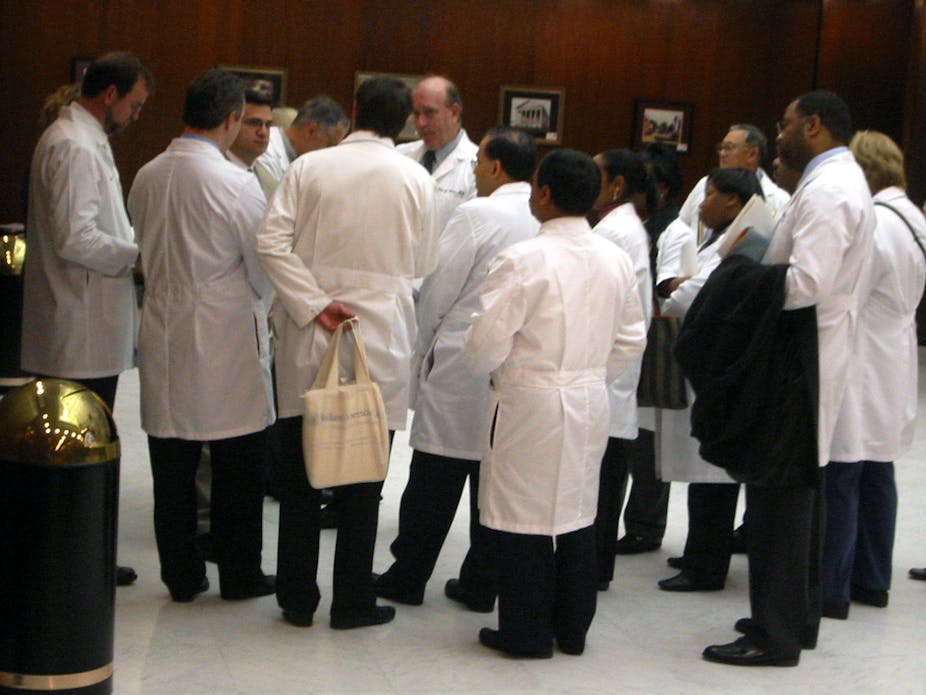TRANSPARENCY AND MEDICINE – A series examining issues from ethics to the evidence in evidence-based medicine, the influence of medical journals to the role of Big Pharma in our present and future health.
Here Paul Komesaroff and colleagues highlight a gap in our understand of conflicts of interest.
The popular media frequently feature stories about surgeons profiting from installation of devices made by companies they hold shares in; professional bodies receiving sponsorship from industry; conference speakers whose travel has been paid for by the makers of products they’re commenting on; and GPs using software displaying drug company logos.
This concern about conflicts of interest (a situation that exists where two or more interests are contradictory and compel incompatible outcomes) is undoubtedly well founded, as a large volume of research shows that financial links between individuals and industry do, in fact, influence decision-making.
And now virtually every institution in the country has a process for addressing the issue and governments, peak bodies and professional bodies all, to a greater or lesser extent, require disclosure of financial interests in settings where a conflict of interest (CoI) may arise.
But for all the attention the subject has attracted, the response has been curiously limited and partial. This reveals a major blind spot in the understanding of both interests and the conflicts they produce.
The blind spot in CoI
The discussion has focused almost exclusively on pecuniary, or financial, interests. But these may play a relatively minor role in medicine. Most doctors or researchers don’t do what they do primarily to increase their material wealth. If making money was their primary goal, they could choose more effective ways of doing so.
The motivations that underlie most decisions in medicine are not financial. Rather they range from an interest in patient care or research or public welfare, to a commitment to certain ideas, principles or values and the desire for personal advancement in career, reputation or status.
These factors are powerful drivers of decisions and actions and are no less capable of generating conflicts than the prospect of monetary rewards. Division of loyalties between the roles of clinician, researcher, administrator or public health practitioner may create serious concerns or anxieties; personal religious or political commitments may undermine the operation of an ethics or policy committee; and the quest for international recognition may overcome the natural caution or circumspection required of clinical judgement.
While it’s easy to highlight this gap in the understanding of conflicts of interest, how to deal with it is not quite as clear. Indeed, the reason why public debates have focused on financial interests and almost completely ignored non-monetary ones is that, by their very nature, the latter are more difficult to define and quantify. And, their impact is more difficult to prove.
The nature of interests
The problem is not simply that we’ve ignored non-pecuniary CoI but that our focus on financial interests has distorted our understanding of what interests are and what it means to say that they’re in conflict.
For starters, interests are not bad things, they refer simply to the ways in which we necessarily and habitually attach value to our relationships and practices. Every social role has associated with it a collection of moral imperatives into which one enters when one assumes that role. This applies regardless of whether you’re a doctor, teacher, researcher, administrator or public servant.

The chance of dualities, multiplicities and conflicts is increased by the great diversity of roles and responsibilities assumed by individuals in modern society. The existence of a CoI is neither unusual nor shameful and doesn’t reflect a psychological aberration. It’s a straightforward, unavoidable fact that we must accept and recognise.
This doesn’t mean that CoIs don’t produce problems. On the contrary, unregulated conflicts, both pecuniary and non-pecuniary, can confound and distort decision-making processes and generate inappropriate and harmful outcomes.
Not for money
Despite the difficulty in defining and evaluating non-financial interests, it’s possible to regulate them in a systematic way. The first, essential step is to recognise the issue and identify the key interests at stake within the setting.
There must also be a process of review or deliberation so relevant stakeholders can decide whether the existence of multiple interests has the capacity to corrupt a decision-making process. If it’s decided that this is the case, action may need to be taken to disengage the conflicting roles. The relevant community will also need to be assured that danger has been averted and the integrity of decisions preserved.
Case studies
The approach for managing these conflicts is the same as in most cases of financial conflicts of interest, but not all. Let’s consider some examples:
A doctor working as both a clinician and a researcher encounters a conflict between the demands of science and clinical care. She recognises her conflicting interests, declares them and, with the help of an ethics committee, entrusts the job of recruiting research participants to an independent assistant;
An individual is approached to participate in a committee to write guidelines for the conduct of research involving embryonic stem cells. He recognizes that his strong religious beliefs would make it impossible for him to engage in the open dialogue required for the task, so after discussion with the chair he declines the invitation to join the committee;
A senior office holder in a professional organisation recognises that the fact that her husband’s role as a senior government official may compromise her independence of judgment. She declares her interests and recuses herself from discussions involving dealings with that government department; or
A surgeon involved in developing a new operation that may not only improve clinical practice but also enhance his personal reputation and standing recognises that he is vulnerable to errors owing to his duality of interests. To protect both himself and his patients, he engages in discussion with colleagues who agree to help guide him in cases where there might be uncertainty about the role of the new procedure.
Of these examples, the last is the most difficult because it depends on a degree of introspection, even if objective criteria may still be recognisable to those around the surgeon. In such cases, we are forced to rely on two things – personal integrity and the vigilance of the community of practitioners in which the affected person works.
Both of these depend on the culture within which all parties operate, including the prevailing ethos of the hospital setting; the standards set by professional organisations; the ability of the educational process to develop the critical qualities of self-knowledge and humility; the level of community awareness; and the readiness of doctors to engage in open dialogues with their patients.
Still an elephant
Non-financial interests are the elephant in the room during discussions about conflicts of interest. Although they’ve received relatively little attention, it’s undeniable that they are as important as monetary interests in the decision-making process, and the risk posed by conflicts involving them is just as great.
With care, they can be recognised and managed, although the procedures involved may at times differ somewhat from those developed to deal with financial issues. Some conflicts of this kind fall into easily definable categories, such as specific roles, relationships or belief systems, while others may concern personal motivations and intentions. The management of these latter may depend on more complex processes.
The management of all conflicts – financial or not – ultimately depend on the existence of a critical culture that both recognises the importance of the issues and provides support and guidance for practitioners.
This is the fifth part of Transparency and Medicine. You can read other instalments by clicking the links below:
Part One: Power and duty: is the social contract in medicine still relevant?
Part Two: Big debts in small packages – the dangers of pens and post-it notes
Part Three: Show and tell: conflicts of interest undeclared for clinical guidelines
Part Four: Eminence or evidence? The ethics of using untested treatments
Part Six: Ghosts in the machine: better definition of author may stem bias
Part Seven: Clearing the air: why more retractions are good for science
Part Eight: Pharma’s influence over published clinical evidence
Part Nine: Insight into how pharma manipulates research evidence: a case study
Part Ten: Why data from published trials should be made public
Part Eleven: Open disclosure: why doctors should be honest about errors
Part Twelve: Reaching full and open disclosure for universities, medical schools and doctors
Part Thirteen: Ethics of accepting suppliers’ gifts in the business v medical world
Part Fourteen: Conflicts of interest in guideline development: the NHMRC responds
Part Fifteen: Consumer input in Medicines Australia’s code of conduct review

